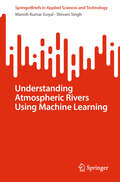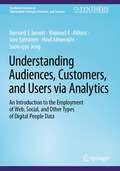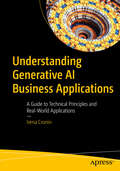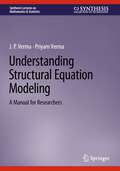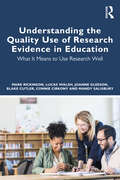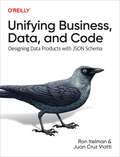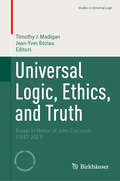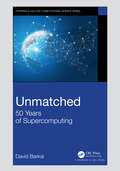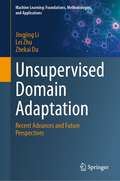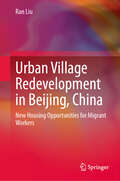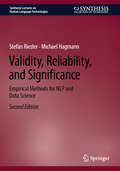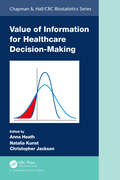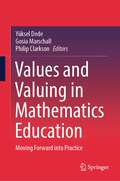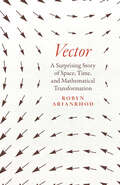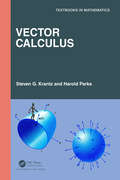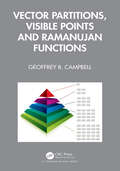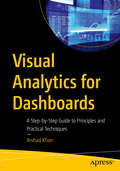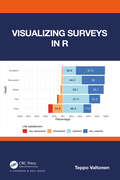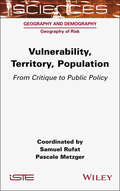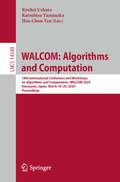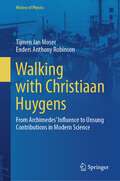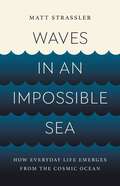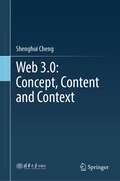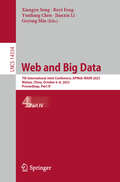- Table View
- List View
Understanding Atmospheric Rivers Using Machine Learning (SpringerBriefs in Applied Sciences and Technology)
by Manish Kumar Goyal Shivam SinghThis book delves into the characterization, impacts, drivers, and predictability of atmospheric rivers (AR). It begins with the historical background and mechanisms governing AR formation, giving insights into the global and regional perspectives of ARs, observing their varying manifestations across different geographical contexts. The book explores the key characteristics of ARs, from their frequency and duration to intensity, unraveling the intricate relationship between atmospheric rivers and precipitation. The book also focus on the intersection of ARs with large-scale climate oscillations, such as El Niño and La Niña events, the North Atlantic Oscillation (NAO), and the Pacific Decadal Oscillation (PDO). The chapters help understand how these climate phenomena influence AR behavior, offering a nuanced perspective on climate modeling and prediction. The book also covers artificial intelligence (AI) applications, from pattern recognition to prediction modeling and early warning systems. A case study on AR prediction using deep learning models exemplifies the practical applications of AI in this domain. The book culminates by underscoring the interdisciplinary nature of AR research and the synergy between atmospheric science, climatology, and artificial intelligence
Understanding Audiences, Customers, and Users via Analytics: An Introduction to the Employment of Web, Social, and Other Types of Digital People Data (Synthesis Lectures on Information Concepts, Retrieval, and Services)
by Bernard J. Jansen Kholoud K. Aldous Joni Salminen Hind Almerekhi Soon-gyo JungThis book presents the foundations of using analytics from the laboratory, social media platforms, and the web. The authors cover key topics including analytics strategy, data gathering approaches, data preprocessing, data quality assessment, analytical methods, tools, and validation methods. The book includes chapters explaining web analytics, social media analytics, and how to create an analytics strategy. The authors also cover on data sources, such as online surveys, crowdsourcing, eye tracking, mouse tracking, social media APIs, search logs, and analytics triangulation. The book also discusses analytical tools for social media analytics, search analytics, persona analytics, user studies, and website analytics. The authors conclude by examining the validity of online analytics.
Understanding Generative AI Business Applications: A Guide to Technical Principles and Real-World Applications
by Irena CroninThis guide covers the fundamental technical principles and various business applications of Generative AI for planning, developing, and evaluating AI-driven products. It equips you with the knowledge you need to harness the potential of Generative AI for enhancing business creativity and productivity.The book is organized into three sections: text-based, senses-based, and rationale-based. Each section provides an in-depth exploration of the specific methods and applications of Generative AI. In the text-based section, you will find detailed discussions on designing algorithms to automate and enhance written communication, including insights into the technical aspects of transformer-based Natural Language Processing (NLP) and chatbot architecture, such as GPT-4, Claude 2, Google Bard, and others. The senses-based section offers a glimpse into the algorithms and data structures that underpin visual, auditory, and multisensory experiences, including NeRF, 3D Gaussian Splatting,Stable Diffusion, AR and VR technologies, and more. The rationale-based section illuminates the decision-making capabilities of AI, with a focus on machine learning and data analytics techniques that empower applications such as simulation models, agents, and autonomous systems.In summary, this book serves as a guide for those seeking to navigate the dynamic landscape of Generative AI. Whether you’re a seasoned AI professional or a business leader looking to harness the power of creative automation, these pages offer a roadmap to leverage Generative AI for your organization’s success.What You Will LearnWhat are the technical elements that constitute the makeup of Generative AI products?What are the practical applications of Generative AI?How can algorithms be designed to automate and improve written communication?What are the latest Generative AI architectures and algorithms?Who This Book Is ForData scientists, data analysts, decision makers, and business executives interested in gaining an understanding of Generative AI products
Understanding Structural Equation Modeling: A Manual for Researchers (Synthesis Lectures on Mathematics & Statistics)
by J.P. Verma Priyam VermaThis book presents a comprehensive overview of Structural Equation Modeling and how it can be applied to address research issues in different disciplines. The authors employ a ‘simple to complex’ approach. The book reviews topics such as variance, covariance, correlation, multiple regression, mediation, moderation, path analysis, and confirmatory factor analysis. The authors then discuss the initial steps for performing structural equation modeling, including model specification, model identification, model estimation, model testing, and model modification. The book includes an introduction to the IBM SPSS and IBM SPSS Amos software. The authors the explain how this software can be utilized for developing measurement, structural models, and SEM models. The book provides conceptual clarity in understanding the models and discusses practical approaches to solving them. The authors also highlight how these techniques can be applied to various disciplines, including psychology, education, sociology, business, medicine, political science, and biological sciences.
Understanding the Quality Use of Research Evidence in Education: What It Means to Use Research Well
by Mark Rickinson Lucas Walsh Joanne Gleeson Blake Cutler Connie Cirkony Mandy SalisburyThis book focuses on the question of how to understand quality use of research evidence in education, or what it means to use research evidence well. Internationally there are widespread efforts to increase the use of research evidence within educational policy and practice. Such efforts raise important questions about how we understand not just the quality of evidence, but also the quality of its use. To date, there has been wide-ranging debate about the former, but very little dialogue about the latter. Based on a five-year study with schools and school systems in Australia, this book sheds new light on: why clarity about quality of use is critical to educational improvement; how quality use of research evidence can be framed in education; what using research well involves and looks like in practice; what quality research use means for individuals, organisations and systems; and what aspects of using research well still need to be better understood. This book will be an invaluable resource for professionals within and beyond education who want to better understand what using research evidence well means and involves and how it can be supported.
Une journée équitable à la foire pour Tommy
by Linda HendersonLa foire promet des expériences intéressantes pour les jeunes et les moins jeunes. Tommy aime particulièrement les manèges et les animaux de la foire. Il aimait aussi faire des additions dans sa tête. C'est ainsi qu'il a découvert qu'il y avait beaucoup de choses à additionner à la foire. Alors qu'il écoutait son oncle Albert calculer le prix des tickets d'entrée, celui-ci lui a donné une leçon de vie sur l'importance de traiter les gens de manière juste et équitable. Nous pouvons tous tirer des leçons de ce que l'oncle Albert a dit à Tommy. Dans ce livre facile à lire pour les 6-8 ans, les enfants peuvent s'amuser avec Tommy et sa famille pendant qu'ils parcourent le champ de foire. Ils peuvent exercer leur esprit en pratiquant les mathématiques. Et à la fin du livre, les enfants découvrent celui qui nous considère tous comme des êtres égaux !
Unifying Business, Data, and Code
by Ron Itelman Juan Cruz ViottiIn the modern symphony of business, each section-from the technical to the managerial-must play in harmony. Authors Ron Itelman and Juan Cruz Viotti introduce a bold methodology to synchronize your business and technical teams, transforming them into a single, high-performing unit. Misalignment between business and technical teams halts innovation. You'll learn how to transcend the root causes of project failure-the ambiguity, knowledge gaps, and blind spots that lead to wasted efforts. The unifying methodology in this book will teach you these alignment tools and more: The four facets of data products: A simple blueprint that encapsulates data and business logic helps eliminate the most common causes of wasted time and misunderstandingThe concept compass: An easy way to identify the biggest sources of misalignmentSuccess spectrums: Define the required knowledge and road map your team needs to achieve successJSON Schema: Leverage JSON and JSON Schema to technically implement the strategy at scale, including extending JSON Schema with custom keywords, understanding JSON Schema annotations, and hosting your own schema registryData hygiene: Learn how to design high-quality datasets aligned with creating real business value, and protect your organization from the most common sources of pain
Universal Logic, Ethics, and Truth: Essays in Honor of John Corcoran (1937-2021) (Studies in Universal Logic)
by Jean-Yves Béziau Timothy J. MadiganJohn Corcoran was a very well-known logician who worked on several areas of logic. He produced decisive works giving a better understanding of two major figures in the history of logic, Aristotle and Boole. Corcoran had a close association with Alfred Tarski, a prominent 20th-century logician. This collaboration manifested in Corcoran's substantial introduction to Tarski's seminal book, Logic, Semantics, Metamathematics (1956). Additionally, Corcoran's posthumous editorial involvement in 'What are logical notions?' (1986) breathed new life into this seminal paper authored by Tarski. His scholarly pursuits extended to the intricate explication of fundamental concepts in modern logic, including variables, propositions, truth, consequences, and categoricity. Corcoran's academic curiosity extended further to the intersection of ethics and logic, reflecting his contemplation of their interrelation. Beyond these theoretical contributions, Corcoran was deeply engaged in the pedagogical dimensions of logic instruction. This volume serves as a compilation of articles contributed by Corcoran's students, colleagues, and international peers. By encompassing a diverse range of subjects, this collection aptly mirrors Corcoran's wide-ranging interests, offering insights that not only deepen our understanding of his work but also advance the theoretical frameworks he explored.
Unmatched: 50 Years of Supercomputing (Chapman & Hall/CRC Computational Science)
by David BarkaiUnmatched: 50 Years of Supercomputing: A Personal Journey Accompanying the Evolution of a Powerful ToolThe rapid and extraordinary progress of supercomputing over the past half-century is a powerful demonstration of our relentless drive to understand and shape the world around us. In this book, David Barkai offers a unique and compelling account of this remarkable technological journey, drawing from his own rich experiences working at the forefront of high-performance computing (HPC).This book is a journey delineated as five decade-long ‘epochs’ defined by the systems’ architectural themes: vector processors, multi-processors, microprocessors, clusters, and accelerators and cloud computing. The final part examines key issues of HPC and discusses where it might be headed.A central goal of this book is to show how computing power has been applied, and, more importantly, how it has impacted and benefitted society. To this end, the use of HPC is illustrated in a range of industries and applications, from weather and climate modeling to engineering and life sciences. As such, this book appeals to both students and general readers with an interest in HPC, as well as industry professionals looking to revolutionize their practice.From the Foreword:“David Barkai's career has spanned five decades, during which he has had the rare opportunity to be part of some of the most significant developments in the field of supercomputing. His personal and professional insights, combined with his deep knowledge and passion for the subject matter, make this book an invaluable resource for anyone interested in the evolution of HPC and its impact on our lives.”-Horst Simon, Director, Abu Dhabi Investment Authority (ADIA) Lab
Unsupervised Domain Adaptation: Recent Advances and Future Perspectives (Machine Learning: Foundations, Methodologies, and Applications)
by Jingjing Li Lei Zhu Zhekai DuUnsupervised domain adaptation (UDA) is a challenging problem in machine learning where the model is trained on a source domain with labeled data and tested on a target domain with unlabeled data. In recent years, UDA has received significant attention from the research community due to its applicability in various real-world scenarios. This book provides a comprehensive review of state-of-the-art UDA methods and explores new variants of UDA that have the potential to advance the field. The book begins with a clear introduction to the UDA problem and is mainly organized into four technical sections, each focused on a specific piece of UDA research. The first section covers criterion optimization-based UDA, which aims to learn domain-invariant representations by minimizing the discrepancy between source and target domains. The second section discusses bi-classifier adversarial learning-based UDA, which creatively leverages adversarial learning by conducting a minimax game between the feature extractor and two task classifiers. The third section introduces source-free UDA, a novel UDA setting that does not require any raw data from the source domain. The fourth section presents active learning for UDA, which combines domain adaptation and active learning to reduce the amount of labeled data needed for adaptation. This book is suitable for researchers, graduate students, and practitioners who are interested in UDA and its applications in various fields, primarily in computer vision. The chapters are authored by leading experts in the field and provide a comprehensive and in-depth analysis of the current UDA methods and new directions for future research. With its broad coverage and cutting-edge research, this book is a valuable resource for anyone looking to advance their knowledge of UDA.
Urban Village Redevelopment in Beijing, China: New Housing Opportunities for Migrant Workers
by Ran LiuThe book provides a multi-stage assessment of the changing housing opportunities of migrant workers in the three stages of Beijing’s urban village development (emergence, erasure and preservation). The volume re-theorizes Henry Lefebvre’s notion of the “right to the city” as a largely property-based concept that falls within the city’s hybrid tenure matrix of varying degrees of tenure security and formality that is undergoing entrepreneurialization or gentrification. This is another highly valuable contribution to China studies from the geographical perspective of the “territorial politics” at play in the process of urban village redevelopment, which has fostered a new propertied landowning class as winners, while moving low-wage migrants. The book takes the reader on a fascinating journey from peri-urban villages to IT worker villages to artists’ villages, revealing a restless landscape of urbanism and state-centered governance, as well as bottom-up counterplots. The fieldwork explores the contradictions of urban village redevelopment in Beijing. On the one hand, it is state-dominated and yet creates new housing opportunities for migrants; on the other, it disrupts old orders but also encourages new forms of grassroots alliances. The empirical studies of Beijing’s urban villages enrich Henry Lefebvre’s discourse on “planetary urbanisation,” Gilles Deleuze and Félix Guattari’s notion of the “rhizome,” and Elinor Ostrom’s ideas on the wise management of the “commons.”
Validity, Reliability, and Significance: Empirical Methods for NLP and Data Science (Synthesis Lectures on Human Language Technologies)
by Stefan Riezler Michael HagmannThis book introduces empirical methods for machine learning with a special focus on applications in natural language processing (NLP) and data science. The authors present problems of validity, reliability, and significance and provide common solutions based on statistical methodology to solve them. The book focuses on model-based empirical methods where data annotations and model predictions are treated as training data for interpretable probabilistic models from the well-understood families of generalized additive models (GAMs) and linear mixed effects models (LMEMs). Based on the interpretable parameters of the trained GAMs or LMEMs, the book presents model-based statistical tests such as a validity test that allows for the detection of circular features that circumvent learning. Furthermore, the book discusses a reliability coefficient using variance decomposition based on random effect parameters of LMEMs. Lastly, a significance test based on the likelihood ratios of nested LMEMs trained on the performance scores of two machine learning models is shown to naturally allow the inclusion of variations in meta-parameter settings into hypothesis testing, and further facilitates a refined system comparison conditional on properties of input data. The book is self-contained with an appendix on the mathematical background of generalized additive models and linear mixed effects models as well as an accompanying webpage with the related R and Python code to replicate the presented experiments. The second edition also features a new hands-on chapter that illustrates how to use the included tools in practical applications.
Value of Information for Healthcare Decision-Making (Chapman & Hall/CRC Biostatistics Series)
by Anna Heath Natalia Kunst Christopher JacksonValue of Information for Healthcare Decision-Making introduces the concept of Value of Information (VOI) use in health policy decision-making to determine the sensitivity of decisions to assumptions, and to prioritise and design future research. These methods, and their use in cost-effectiveness analysis, are increasingly acknowledged by health technology assessment authorities as vital. Key Features: Provides a comprehensive overview of VOI Simplifies VOI Showcases state-of-the-art techniques for computing VOI Includes R statistical software package Provides results when using VOI methods Uses realistic decision model to illustrate key concepts The primary audience for this book is health economic modellers and researchers, in industry, government, or academia, who wish to perform VOI analysis in health economic evaluations. It is relevant for postgraduate researchers and students in health economics or medical statistics who are required to learn the principles of VOI or undertake VOI analyses in their projects. The overall goal is to improve the understanding of these methods and make them easier to use.
Values and Valuing in Mathematics Education: Moving Forward into Practice
by Yüksel Dede Gosia Marschall Philip ClarksonThis book is a follow-up to 'Values and Valuing in Mathematics Education: Scanning and Scoping the Territory' (2019, Springer). This book adds a critical emphasis on practice and fosters thinking concerning positive mathematical well-being, engagement, teacher noticing, and values alignment among a range of critical notions that intersect with values and valuing. Values and valuing play a key role in many aspects of education, such as assessment, planning, classroom interactions, choosing tasks, and general well-being. What one values and finds important in the learning and teaching of mathematics operates within the intersection of all social, cognitive, and affective aspects of school pedagogy, making values a significant holistic factor in education. The chapters explore potential teaching strategies that enhance the understanding of the central place of values in mathematics itself as a subject, as well as how values impact how mathematics is used withinsociety. This book includes examples of strategies for facilitating students’ meaningful engagement with, and conscious learning of, values when engaging in mathematical thinking and doing.
Vector: A Surprising Story of Space, Time, and Mathematical Transformation
by Robyn ArianrhodA celebration of the seemingly simple idea that allowed us to imagine the world in new dimensions—sparking both controversy and discovery. The stars of this book, vectors and tensors, are unlikely celebrities. If you ever took a physics course, the word “vector” might remind you of the mathematics needed to determine forces on an amusement park ride, a turbine, or a projectile. You might also remember that a vector is a quantity that has magnitude and (this is the key) direction. In fact, vectors are examples of tensors, which can represent even more data. It sounds simple enough—and yet, as award-winning science writer Robyn Arianrhod shows in this riveting story, the idea of a single symbol expressing more than one thing at once was millennia in the making. And without that idea, we wouldn’t have such a deep understanding of our world. Vector and tensor calculus offers an elegant language for expressing the way things behave in space and time, and Arianrhod shows how this enabled physicists and mathematicians to think in a brand-new way. These include James Clerk Maxwell when he ushered in the wireless electromagnetic age; Einstein when he predicted the curving of space-time and the existence of gravitational waves; Paul Dirac, when he created quantum field theory; and Emmy Noether, when she connected mathematical symmetry and the conservation of energy. For it turned out that it’s not just physical quantities and dimensions that vectors and tensors can represent, but other dimensions and other kinds of information, too. This is why physicists and mathematicians can speak of four-dimensional space-time and other higher-dimensional “spaces,” and why you’re likely relying on vectors or tensors whenever you use digital applications such as search engines, GPS, or your mobile phone. In exploring the evolution of vectors and tensors—and introducing the fascinating people who gave them to us—Arianrhod takes readers on an extraordinary, five-thousand-year journey through the human imagination. She shows the genius required to reimagine the world—and how a clever mathematical construct can dramatically change discovery’s direction.
Vector Calculus (Textbooks in Mathematics)
by Harold Parks Steven G. KrantzUsing meaningful examples, credible applications, and incisive technology, Vector Calculus strives to empower students, enhance their critical thinking skills, and equip them with the knowledge and skills to succeed in the major or discipline they ultimately choose to study. This text is intended to be a cornerstone of that process. An engaging style and clear writing make the language of mathematics accessible, understandable, and enjoyable, with a high standard for mathematical rigor.A calculus book must tell the truth. This book is carefully written in the accepted language of mathematics in a readable exposition. It includes useful and fascinating applications, acquaints students with the history of the subject, and offers a sense of what mathematics is all about.Technique is presented, yet so are ideas. The authors help students to master basic methods and discover and build their own concepts in a scientific subject. There is an emphasis on using modeling and numerical calculation. Additional features include: A Quick Quiz and Problems for Practice, Further Theory and Practice, and Calculator/Computer Exercises appear at the end of each section All exercise sets are step laddered A Look Back and A Look Forward help students put the ideas in context Every chapter ends with a Genesis and Development section, giving history and perspective on key topics in the evolution of calculus Boxed Insights clear up points or answer commonly asked questions The text has an extra-large offering of examples Examples are illustrated with meaningful and useful graphics The pedagogical features make the subject more interesting and accessible to students than other texts, while maintaining an appropriate rigor. —Daniel Cunningham, CSU-FresnoThis text is truly well written and organized. I do like the fact the book is quite rigorous, yet full of illustrative examples. —Bob Devaney, Boston University
Vector Partitions, Visible Points and Ramanujan Functions
by Geoffrey B. CampbellVector Partitions, Visible Points and Ramanujan Functions offers a novel theory of Vector Partitions, though very much grounded in the long-established work of others, that could be developed as an extension to the existing theory of Integer Partitions. The book is suitable for graduate students in physics, applied mathematics, number theory and computational mathematics. It takes the reader up to research level, presenting new results alongside known classical results from integer partitions and areas of vector and multipartite partition theory. It also sets forth new directions for research for the more advanced reader.Above all, the intention of the book is to bring new inspiration to others who study mathematics and related areas. It is hoped that some new ideas will be launched to add value and insight into many of the classical and new theories surrounding partitions. The book is an appreciation of the many gifted authors of research into partitions over the past century and before, in the hope that more may come of this for future generations.Features Provides a step-by-step guide through the known literature on Integer and Vector Partitions, and a focus on the not so well-known Visible Point Vector identities Serves as a reference for graduate students and researchers in physics, applied mathematics, number theory and computational mathematics Offers a variety of practical examples as well as sets of exercises suitable for students and researchers Geoffrey B. Campbell completed his PhD at Australian National University in 1998 under the esteemed physicist Professor Rodney Baxter. His affiliation with the Australian National University Mathematical Sciences Institute has continued for over 30 years. Within that time frame, Geoffrey also served eight years as an Honorary Research Fellow at LaTrobe University Mathematics and Statistics Department in Melbourne. Currently he writes ongoing articles for the Australian Mathematical Society Gazette. Within the international scope, Geoffrey currently serves as a PhD external committee member for a mathematics graduate student at Washington State University in America.Geoffrey has built a career within Australian Commonwealth and State government departments, including as an Advisor at the Department of Prime Minister and Cabinet; as Analyst Researcher for a Royal Commission. Geoffrey specializes in complex data, machine learning including data analytics. He is also a published poet in Australian anthologies and literary magazines.
Visual Analytics for Dashboards: A Step-by-Step Guide to Principles and Practical Techniques
by Arshad KhanThis book covers the key principles, best practices, and practical techniques for designing and implementing visually compelling dashboards. It explores the various stages of the dashboard development process, from understanding user needs and defining goals, to selecting appropriate visual encodings, designing effective layouts, and employing interactive elements. It also addresses the critical aspect of data storytelling, examining how narratives and context can be woven into dashboards to deliver impactful insights and engage audiences. Visual Analytics for Dashboards is designed to cater to a wide range of readers, from beginners looking to grasp the fundamentals of visual analytics, to seasoned professionals seeking to enhance their dashboard design skills. For different types of readers, such as a data analyst, BI professional, data scientist, or simply someone interested in data visualization, this book aims to equip them with the knowledge and tools necessary to create impactful dashboards. What you’ll learn The principles of data visualization How to create effective dashboards Meet all the requirements for visual analytics/data visualization/dashboard courses Deepen understanding of data presentation and analysis How to use different kinds of tools for data analysis, such as scorecards and key performance indicators Who This Book Is For Business analysts, data analysts, BI professionals, end-users, executives, developers, as well as students in dashboards, data visualizations, and visual analytics courses.
Visualizing Surveys in R
by Teppo ValtonenVisualizing Surveys in R is about creating static, print quality figures from survey data using R. The focus is not, for example, on statistical analysis of survey data, but rather on giving concrete solutions for typical problems in visualizing survey data. While there are many excellent books on data visualization, surveys and R, the aim of this book is to bring these topics together, and offer practical instructions for visualizing surveys in R. Features • Introduction to survey data: variables, categories, and scales • Description of a process for visualizing survey data • Recommendations for reading survey data into R • Advice on building a survey dataset in R to facilitate versatile plotting • Step-by-step recipes in R for creating useful plots from survey data The book is intended for researchers who regularly use surveys and are interested in learning how to seize the vast possibilities and the flexibility of R in survey analysis and visualizations. The book is also valuable for psychologists, marketeers, HR personnel, managers, and other professionals who wish to standardize and automate the process for visualizing survey data. Finally, the book is suitable as a course textbook, either more widely on survey studies, or more strictly on visualizing survey data in R.
Vulnerability, Territory, Population: From Critique to Public Policy
by Samuel Rufat Pascale MetzgerDuring the Covid-19 pandemic, the term "vulnerable" was applied to "individuals" and to "populations", "groups" and "countries" in discussions, laws and regulations; now it applies to all objects in relation to all kinds of threats. However, rather than a label for governing people and places, the notion of "vulnerability" was expected to become an instrument to tackle the root causes of disasters, poverty and maldevelopment, as well as the inequalities and injustices they bring, whether social, political, economic or environmental. Despite this radical dimension, vulnerability has gradually been incorporated into public policies and international recommendations for global risk and disaster management. This book is intended for researchers, students, managers and decision makers concerned with the management of not only risks and crises but also climate and environmental change. The first part examines the multiple theoretical and conceptual approaches; the second explores vulnerability assessments, using examples from the Global North and Global South; and the third discusses tools, public policies and actions taken to reduce vulnerability.
WALCOM: 18th International Conference and Workshops on Algorithms and Computation, WALCOM 2024, Kanazawa, Japan, March 18–20, 2024, Proceedings (Lecture Notes in Computer Science #14549)
by Ryuhei Uehara Katsuhisa Yamanaka Hsu-Chun YenThis book constitutes the refereed proceedings of the 18th International Conference and Workshops on Algorithms and Computation, WALCOM 2024, held in Kanazawa, Japan, during March 18–20, 2024. The 28 full papers presented in this book, together with two extended abstracts of invited talks, were carefully reviewed and selected from 80 submissions. They cover diverse areas of algorithms and computation, that is, approximation algorithms, algorithmic graph theory and combinatorics, combinatorial algorithms, combinatorial optimization, computational biology, combinatorial reconfiguration, computational complexity, computational geometry, discrete geometry, data structures, experimental algorithm methodologies, graph algorithms, graph drawing, parallel and distributed algorithms, parameterized algorithms, parameterized complexity, network optimization, online algorithms, randomized algorithms, and string algorithms.
Walking with Christiaan Huygens: From Archimedes' Influence to Unsung Contributions in Modern Science (History of Physics)
by Tijmen Jan Moser Enders Anthony RobinsonDutch scientist Christiaan Huygens (1629-1695) left an indelible mark on the fields of mathematics, physics, astronomy, and geophysics. Despite his groundbreaking contributions, history has often overlooked his pivotal role. While two of the most famous achievements in physics are Newton’s theory of gravity and Einstein’s general theory of relativity, less well-known is that Huygens provided central elements to these theories. This book stands to correct that deficit. For example, we show how Huygens used symmetry arguments to derive conservation laws for momentum and for energy, and what Einstein later called the principle of equivalence to derive the formula for centrifugal force. In 1689, Huygens visited Newton. Together, they walked the streets of London. Newton had recently finished his masterpiece, Principia, expounding his laws of motion and the law of universal gravitation. Huygens had essentially completed his life’s work by then, building on Archimedes, Leonardo da Vinci, Galileo, Descartes, Fermat, Pascal and his own ingenuity. He had established fame as an instrument maker (telescope, pendulum clock, planetarium). He had invented the 31 tone system. He had pioneered the first principles of remote sensing. He had discovered the rings of Saturn. He had formulated the wave theory of light. What would walking with Christiaan reveal? This book gives the result in nine chapters, namely: spontaneous order, the speed of light, Huygens’ principle, the telescope, the pendulum clock, Huygens-Fresnel principle, special relativity, centrifugal force, and curvature. In addition, there is a chapter titled What Huygens could have written on diffraction, and a chapter titled Huygens and Geophysics. Mentally walking with Christiaan, browsing his collected works — a true treasure trove for puzzle enthusiasts — and rethinking his ideas creates a vivid impression of scientific life in the 17th century, an appreciation that it is remarkably similar to ours, and an understanding of Huygens' significant and lasting contributions to science.
Waves in an Impossible Sea: How Everyday Life Emerges from the Cosmic Ocean
by Matt StrasslerA theoretical physicist takes readers on an awe-inspiring journey—found in "no other book" (Science)—to discover how the universe generates everything from nothing at all: "If you want to know what's really going on in the realms of relativity and particle physics, read this book" (Sean Carroll, author of The Biggest Ideas in the Universe). In Waves in an Impossible Sea, physicist Matt Strassler tells a startling tale of elementary particles, human experience, and empty space. He begins with a simple mystery of motion. When we drive at highway speeds with the windows down, the wind beats against our faces. Yet our planet hurtles through the cosmos at 150 miles per second, and we feel nothing of it. How can our voyage be so tranquil when, as Einstein discovered, matter warps space, and space deflects matter? The answer, Strassler reveals, is that empty space is a sea, albeit a paradoxically strange one. Much like water and air, it ripples in various ways, and we ourselves, made from its ripples, can move through space as effortlessly as waves crossing an ocean. Deftly weaving together daily experience and fundamental physics—the musical universe, the enigmatic quantum, cosmic fields, and the Higgs boson—Strassler shows us how all things, familiar and unfamiliar, emerge from what seems like nothing at all. Accessible and profound, Waves in an Impossible Sea is the ultimate guide to our place in the universe.
Web 3.0: Concept, Content and Context
by Shenghui ChengAs technology continues to advance, the Internet is evolving into what is often referred to as Web 3.0. This book aims to achieve three main objectives, first, it introduces Web 3.0 systematically and comprehensively, providing readers with a foundational understanding of its concepts and characteristics. Second, it analyzes the inevitability and development necessity of Web 3.0, as well as its potential future possibilities and transformative effects. Finally, it explores Web 3.0 through comparative analysis, discussing its relationship with the metaverse as well as how individuals and organizations can seize the opportunities presented by Web 3.0. Various topics related to Web 3.0, including its infrastructure, development facilities, scenario applications, technology stacks, and industry applications such as decentralized applications (DApps) and Software-as-a-Service (SaaS) platforms are presented in the book. It delves into the ecosystem of Web 3.0, discussing decentralized autonomous organizations (DAOs), open finance (DeFi), cryptocurrencies, token economy, digital identity, creator economy, attention economy, and cyber-physical and human systems. Additionally, it addresses governance issues, security challenges, development challenges, and legal and regulatory aspects associated with Web 3.0. Overall, Web 3.0: Concept, Content and Context provides readers with a comprehensive understanding of Web 3.0, its potential implications, and the opportunities for new industry models and business opportunities in the evolving Internet era.
Web and Big Data: 7th International Joint Conference, APWeb-WAIM 2023, Wuhan, China, October 6–8, 2023, Proceedings, Part IV (Lecture Notes in Computer Science #14334)
by Xiangyu Song Ruyi Feng Yunliang Chen Jianxin Li Geyong MinThe 4-volume set LNCS 14331, 14332, 14333, and 14334 constitutes the refereed proceedings of the 7th International Joint Conference, APWeb-WAIM 2023, which took place in Wuhan, China, in October 2023. The total of 138 papers included in the proceedings were carefully reviewed and selected from 434 submissions. They focus on innovative ideas, original research findings, case study results, and experienced insights in the areas of the World Wide Web and big data, covering Web technologies, database systems, information management, software engineering, knowledge graph, recommend system and big data.
